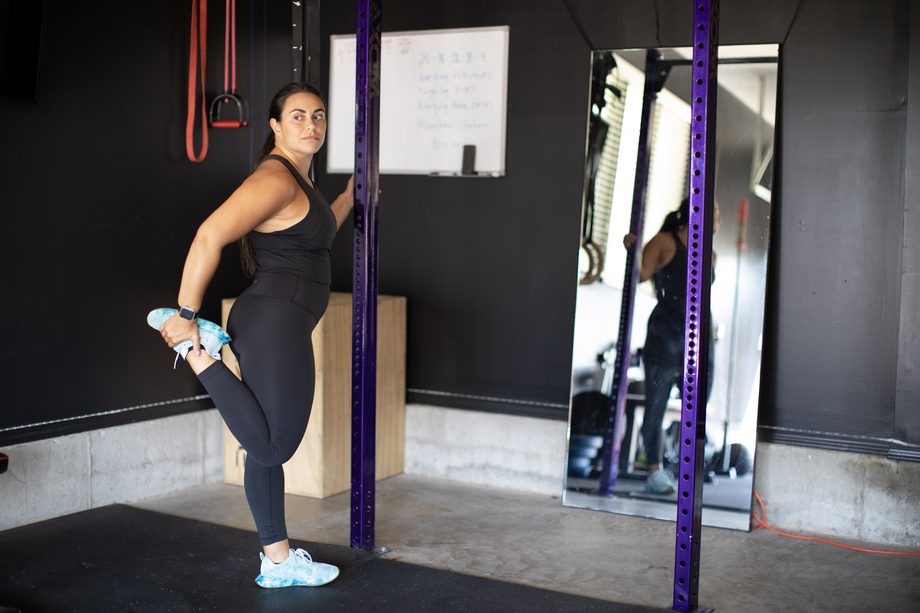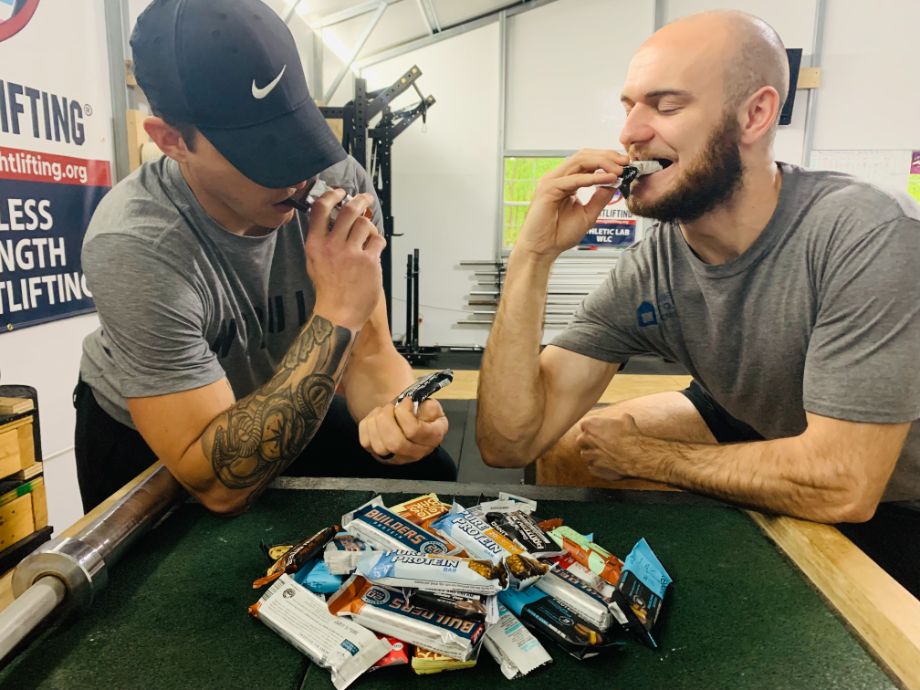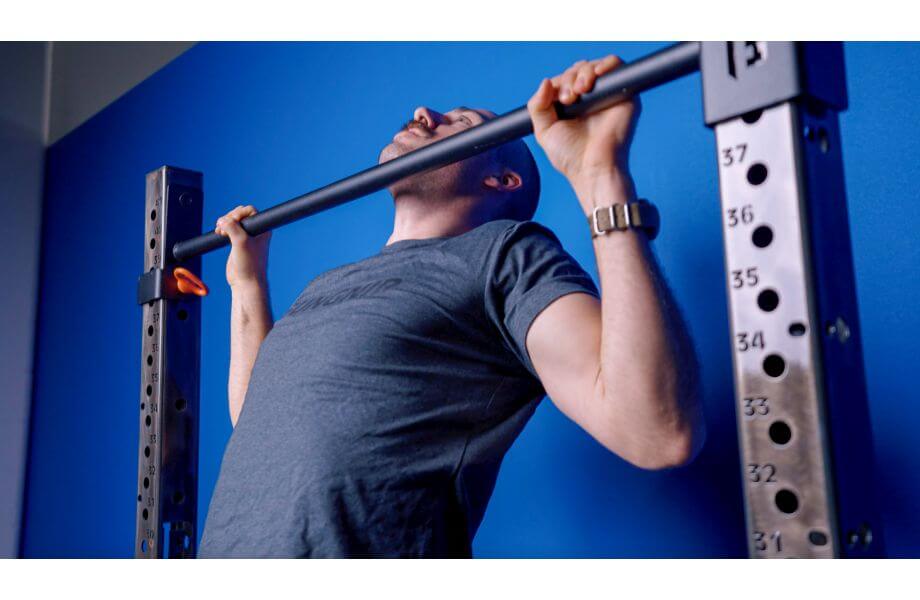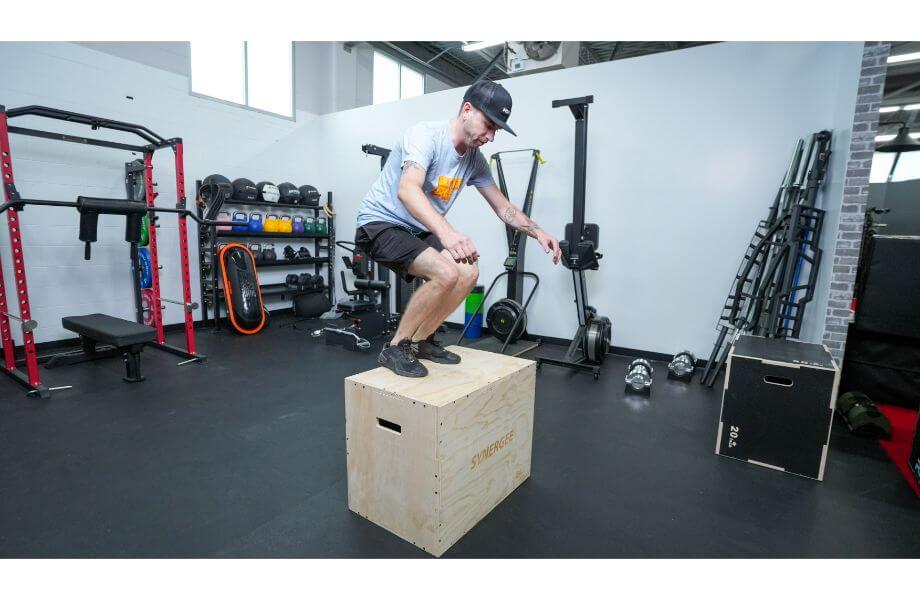Before beginning any physical activity, you’ll likely do some warm-up exercises to get your blood pumping. It might sometimes feel like a chore, but you understand warming up can improve your athletic performance—as a 2010 study by the Journal of Strength and Conditioning Research1 cosigns—because warming up increases your body temperature, elevates your heart rate, increases your blood flow, loosens your muscles and joints, and more.
But as soon as your workout is complete, you’re probably rushing to the car to carry on with your day. Not so fast! What about the opposite—cool down exercises? Doing static stretches and dynamic stretches as the capper at the end of a workout can help return your heart rate and body temperature to pre-exercise levels, reduce lactic acid, and increase flexibility for future workouts.
The great thing about your cool down routine is that it only needs to last a few minutes to be effective. I—a certified personal trainer (CPT)—will show you how to perform my picks for 14 best cool down exercises step-by-step. I’ll then go into the benefits, before explaining how you can program them into your routine for post-workout gains.
RELATED: The Science Of Post-Workout Recovery
14 Best Cool Down Exercises
Let’s get straight to it! Read on for the best cool down exercises you should try:
Forward Bend (or Fold)
Muscles worked: Hamstrings, glutes, lower back, hip flexors
Why do it: If you feel muscle soreness in the posterior chain a day or two after a workout—maybe following a heavy leg day—this hamstring stretch is a fantastic cool down exercise because it lengthens and stretches the entire back of the body.
Those dealing with low back pain due to their desk job can’t go wrong with this exercise. We’ve even included it in our office workout.
How to do it:
- Stand upright with your feet hip-width apart. You’ll want your arms at your sides and a slight bend in your knees.
- Using your hips, slowly bend forward until your hands touch the floor (or as close to it as possible).
- Pause before reversing the motion to return to the starting position.
- Continue for the desired number of reps.
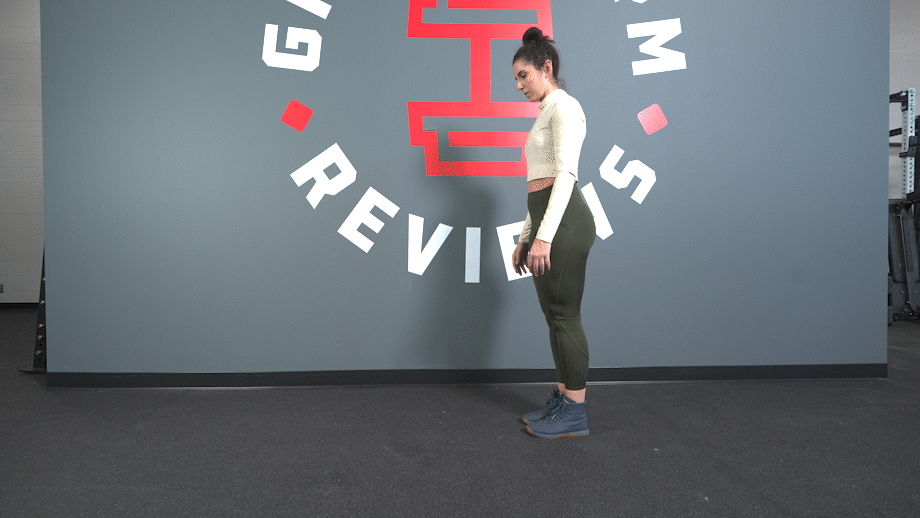
Knee-to-Chest Pose
Muscles worked: Lower back
Why do it: The knee-to-chest pose is included in a group of exercises called the Williams Back Exercises2. These are recommended to people with low back pain to help improve lumbar flexion and strengthen the gluteal and abdominal muscles, especially those who don’t want to undergo lower back surgery.
How to do it:
- Lie down with your knees bent so the soles of your feet are flat on the floor.
- Keeping your right foot where it is, place both hands on your left knee and bring it toward your chest.
- Hold for 30 to 60 seconds before lowering your left foot to the ground. Repeat on the right side.
- Keep going for repetitions.
Expert tip: Although I’ve described the single knee-to-chest pose above, you can perform it with both knees simultaneously. I prefer the former, but try both to see what works for you.
RELATED: Thoracic Mobility Exercises
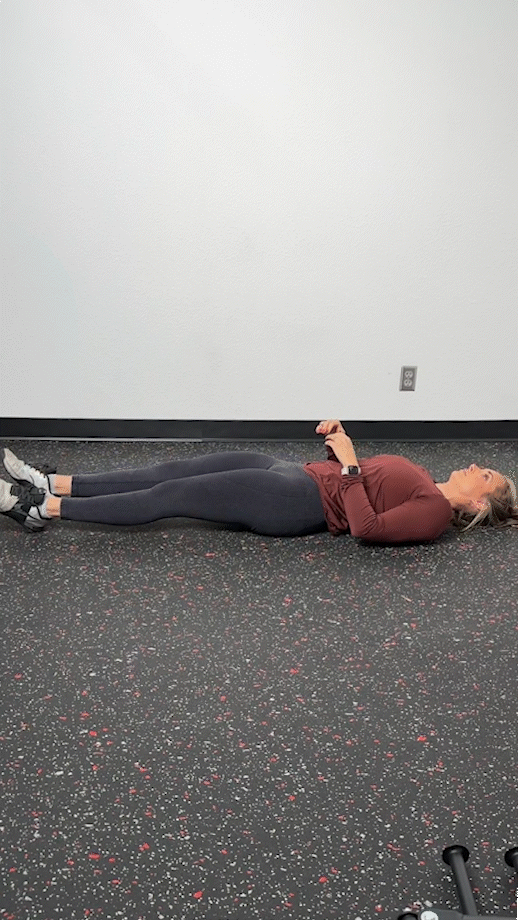
Standing Quad Stretch
Muscles worked: Quadriceps
Why do it: The quads are found at the front of the thigh, and are responsible for extending the knee3 and assisting with hip flexion. Stretching them helps increase flexibility and range of motion in the knee and hip joints, reducing the risk of injury and helping with activities such as walking, running, and strength-training exercises such as back squats.
How to do it:
- Stand tall with your feet shoulder-width apart.
- Lift your left foot toward your butt so you’re standing on your right leg. Take hold of your left ankle with your left hand.
- Ensuring your chest is sticking up and your knees are close to each other, hold this position for approximately 20 seconds.
- Drop the left leg down and switch sides, grabbing your right ankle with your right hand.
- Repeat for reps.
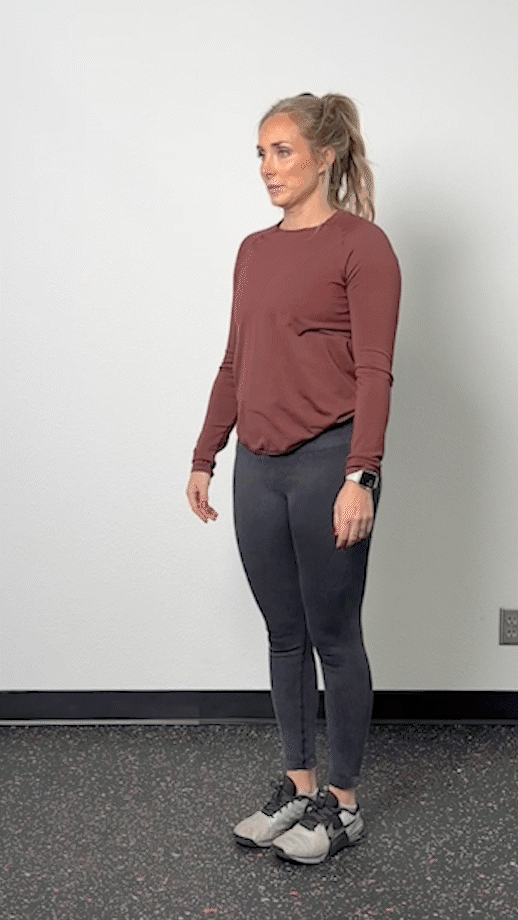
Downward Dog
Muscles worked: Upper back, shoulders, arms, hamstrings, glutes, calves, core
Why do it: Downward dog is a popular exercise in the yoga and Pilates world because it activates the upper and lower body. This is unique because most cool down exercises target one or the other. Because of the inverted position, you may also improve your circulation and blood flow to your head.
How to do it:
- Get onto the floor (or use one of the best exercise mats). You’ll want your knees and toes on the ground, and your palms on the floor, shoulder-width apart.
- Pressing your palms into the ground, lift your knees off the floor. Bring your hips up and back.
- At the same time, move your chest toward your feet so your head is between your shoulders. You’ll now be in an inverted V position.
- Hold this position for the desired length of time.
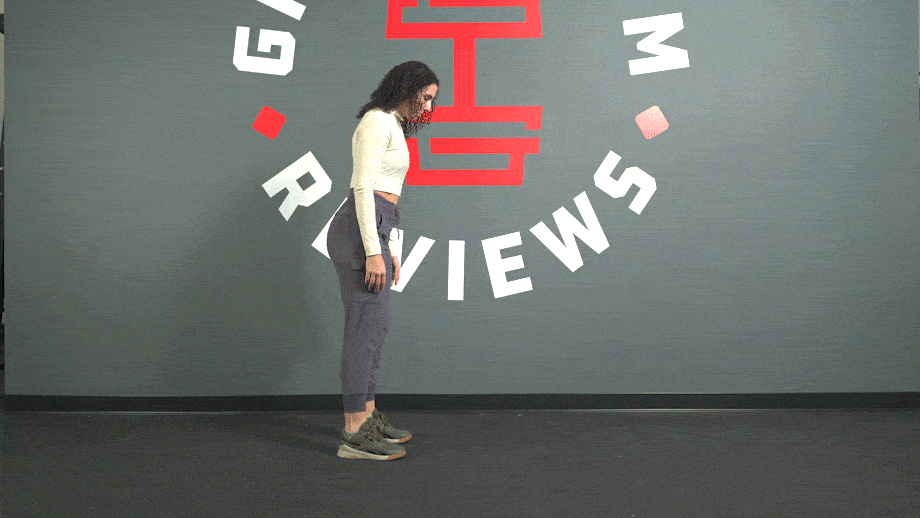
Cat-Cow Stretch
Muscles worked: Lower back, core, hip flexors, upper back
Why do it: Adding this cool down stretch will strengthen and improve mobility in your spine because you’re rotating between flexion and extension. You’ll also improve stability in your core muscles and work your neck and lower back simultaneously. Meow-moo, indeed.
How to do it:
- Begin the movement on your hands and knees, with your hands positioned shoulder-width apart.
- Inhale, then slowly lift your chin up while curving your lower back (this is the cow position). Pause.
- To get into the cat position, pull your belly button toward your spine and chin toward your chest (so your back is rounded). Exhale as you do this.
- Flow between the two positions for the desired number of repetitions or duration.
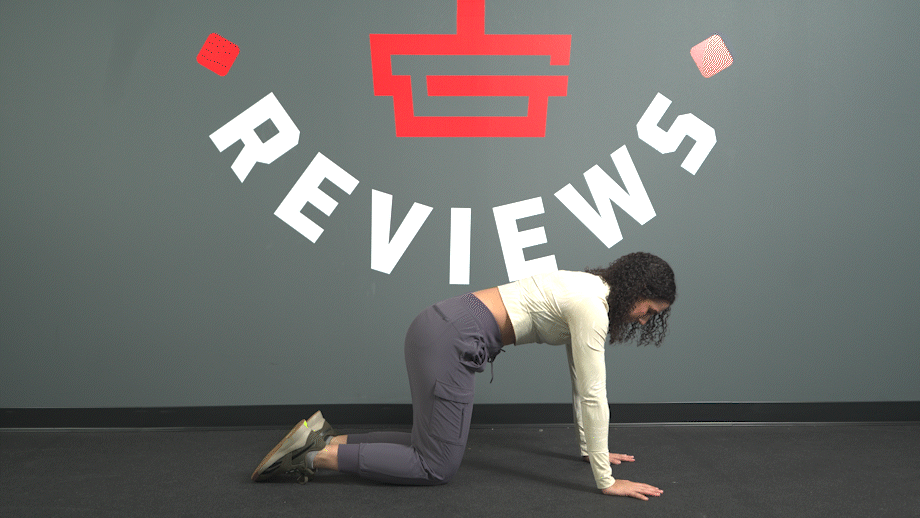
Pigeon Pose
Muscles worked: Hip flexors, glutes, lower back, piriformis
Why do it: You’ll benefit from flexibility and mobility in the hip joints by doing this exercise. A 2019 study by the International Journal of Yoga4 indicated that yoga exercises (including the pigeon pose) can help improve the symptoms of chronic lower back pain.
How to do it:
- Start in the downward dog position (as described above).
- Bring your left foot off the floor and move it toward your left wrist. Place your left knee and left shin on the ground.
- Extend your right leg behind you. Sit up so there’s a straight line between your left hip and knee.
- Walk your hands forward, and depending on your flexibility, you can begin to bring your forehead as close to the floor as possible.
- Hold for the desired length of time, then reverse the motion to get back into the downward dog position.
- Repeat on the other side.
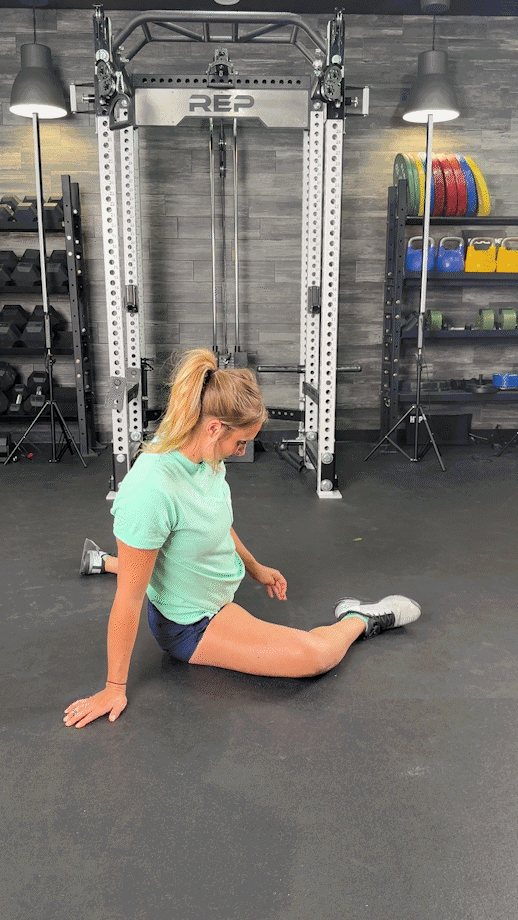
World’s Greatest Stretch
Muscles worked: Hamstrings, quads, glutes, hip flexors, shoulders, chest, upper back, lower back, core
Why do it: With a name like this, you’d be crazy not to do it! It’s a full-body stretch that hits every muscle group, which is ideal for those who are limited on time and want to choose just one or two cool down exercises to do after every workout session.
How to do it:
- Get into the high plank position (also known as the push-up position).
- Step your left foot forward toward the outside of your left hand.
- Press your right hand onto the floor. Now, twist your torso and reach your left hand toward the ceiling.
- When you can’t rotate any further, pause. You’ll want to bring your gaze up to your left fingertips here.
- Return to the high plank position in a controller manner, then do the same movement on the opposite side.
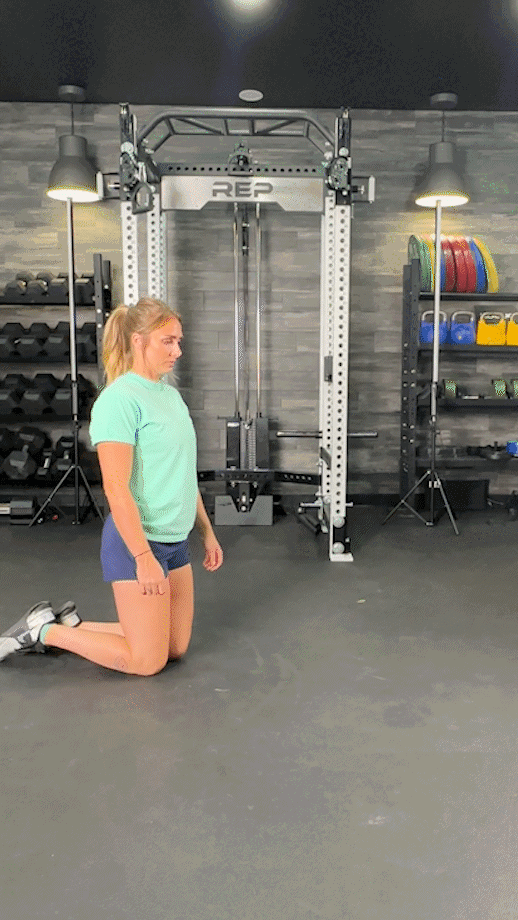
Chest Stretch
Muscles worked: Chest, shoulders
Why do it: Stretches for the chest are hard to come by (there aren’t as many upper-body cool down exercises as lower-body), but this is a fantastic stretch after you’ve done the best chest exercises. Repeated use of this stretch after training can also help combat poor posture because your chest and shoulders need to stay upright throughout the movement.
How to do it:
- Stand upright with your feet shoulder-width apart. Clasp your hands together behind your back.
- With your arms straight and a slight knee bend, fold forward while bringing your arms up behind your back.
- Hold the position for a few moments before returning to the starting position.
- Continue for the desired number of repetitions or duration.
Expert tip: The above is the standing version of the chest stretch, but you can also do seated if you prefer.
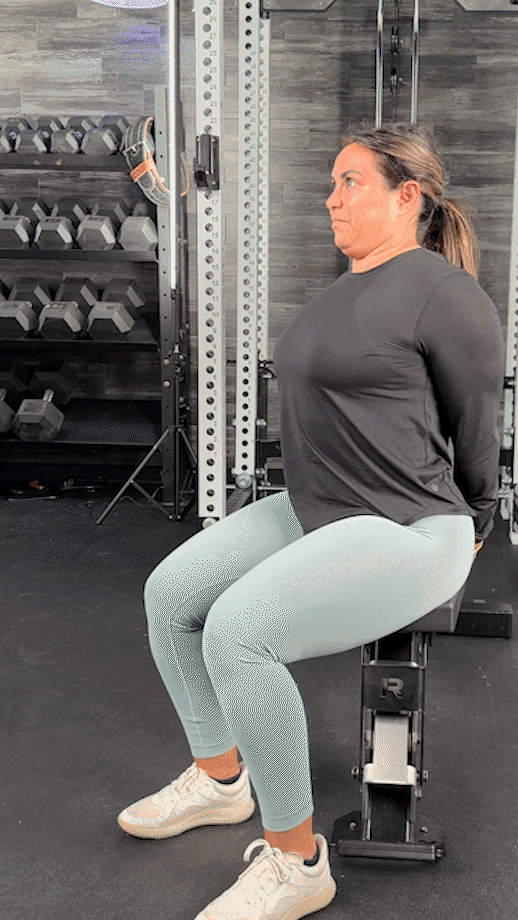
Cross-Body Shoulder Stretch
Muscles worked: Shoulders
Why do it: You use your shoulders in the majority of upper body lifts in the gym, including dumbbell shoulder presses, bench presses, pull-ups, barbell rows, and more. This exercise can improve your range of motion and flexibility, making these lifts easier. Reaching for an item on a shelf requires the cooperation of your shoulders, so it may help to improve your quality of life.
How to do it:
- Stand tall with your feet hip-width apart.
- Reach your left arm across and in front of your right shoulder, making sure that your arm is straight.
- Place your right hand on your left elbow to bring your left arm closer to your body.
- Hold for 20 to 30 seconds, and then repeat with the right arm.
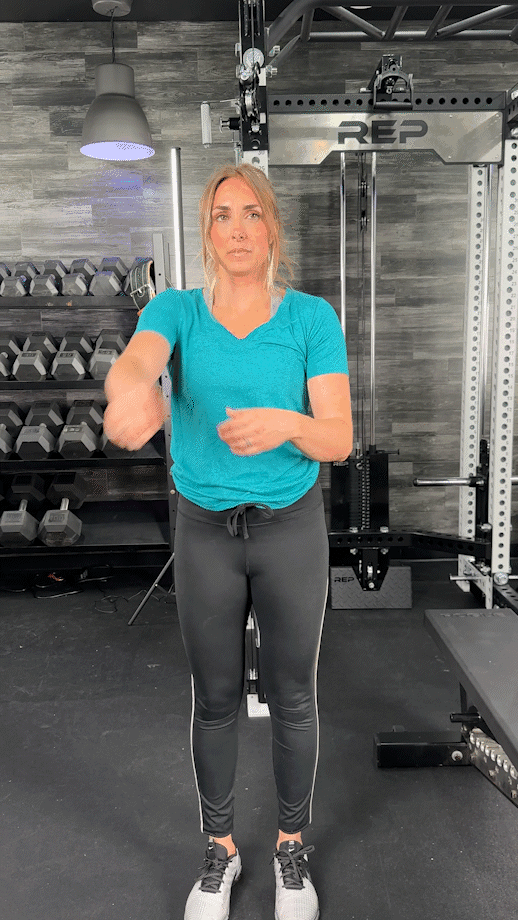
Overhead Triceps Stretch
Muscles worked: Triceps
Why do it: Although the primary function of the triceps is to extend the forearm at the elbow joint5, it also stabilizes the elbow when you’re writing or typing. Performing this cool down exercise can reduce the effects of tight triceps. We like it so much we even included the triceps stretch in our article on at-work stretches.
How to do it:
- In either a standing or seated position, roll your shoulders back and down.
- Lift your left arm, then bend it at the elbow to place your left hand at the back of your body, just below the neck.
- Place your right hand on the left elbow. Pull lightly until you feel your left tricep working.
- Maintain this position before repeating on the opposite side.
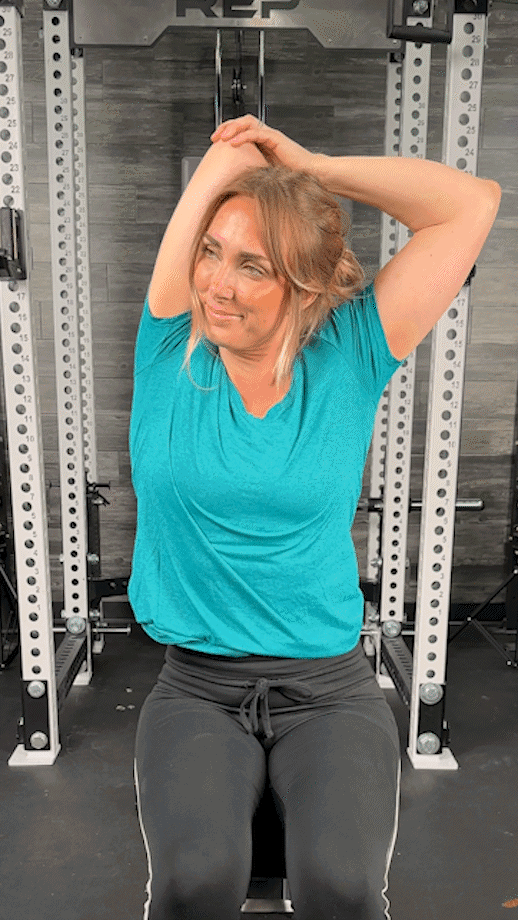
Iron Cross Stretch
Muscles worked: Glutes, hamstrings, hip flexors, core, lower back
Why do it: The iron cross stretch (sounds metal) increases mobility and range of motion in the hip joints and strengthens the lower back and core muscles. I like that you work one side at a time because you can’t cheat the movement, which helps fix muscular imbalances.
How to do it:
- Lie down on the floor, facing up (or supine). Your legs should be extended and close together, but your arms will need to be out to the sides (so you’re in a “T” shape).
- Keeping your right leg where it is, lift your left leg in the air, perpendicular to the body.
- Ensuring that the upper back stays grounded, rotate your hips and bring your left leg toward the right side of the body. If you can, tap your left foot on the floor.
- In a controlled manner, return your left leg to the center, and then back on the ground.
- Repeat the movement so your right leg goes to the left side, continuing for repetitions.
Expert tip: If you’re doing this stretch for the first time or have limited mobility, it’s likely you won’t be able to tap your feet on the floor. That’s fine—don’t push it and pause wherever you feel comfortable.
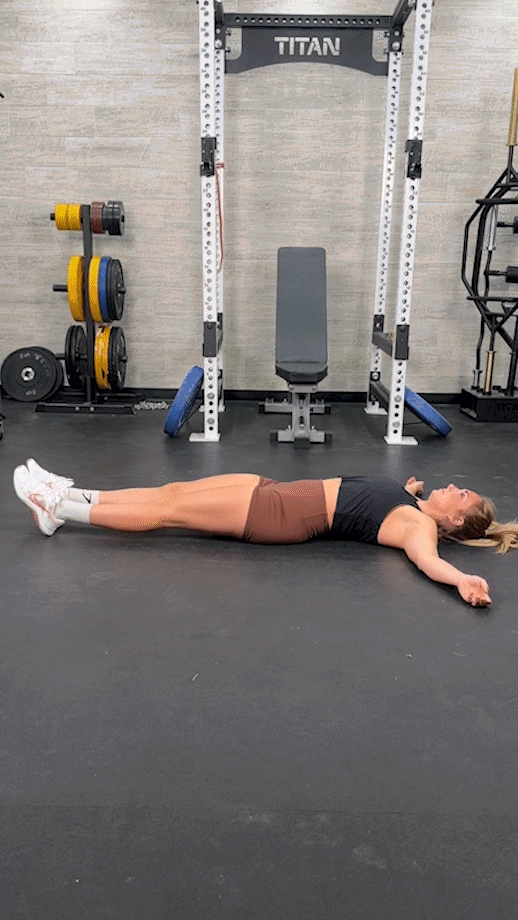
Neck Circles
Muscles worked: Neck, trapezius
Why do it: Neck circles can alleviate neck pain by loosening up the muscles. A 2007 study by the European Spine Journal6 found that work-related neck disorders are common problems in office workers, especially among intensive computer users.
How to do it:
- Begin with your head in a neutral position and your gaze straight ahead. You can either sit or stand for this exercise.
- Tuck your chin toward your chest, then slowly rotate your neck in a clockwise motion so it goes in a full circle (first to your left shoulder, then up in the air, then to your right shoulder).
- Once you’re back at the center, replicate the movement in an anti-clockwise motion.
- Cycle between the two positions for the desired duration.
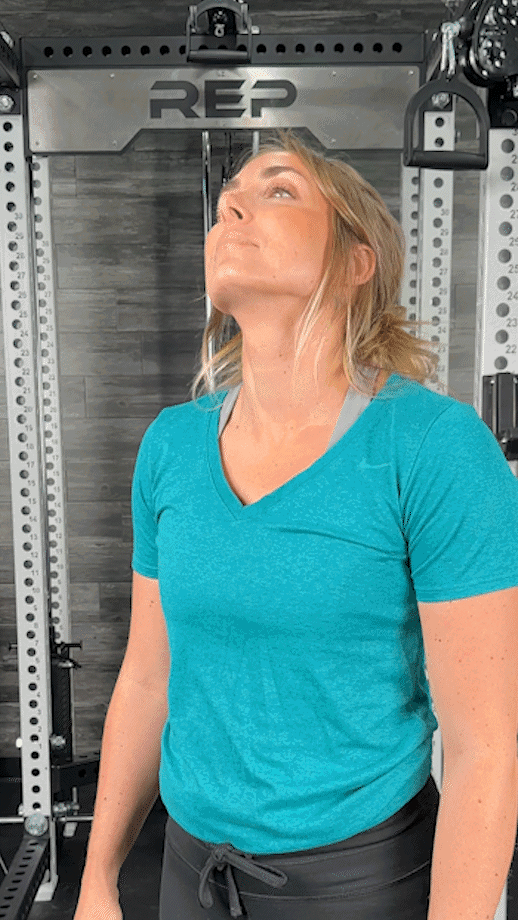
Child’s Pose
Muscles worked: Lower back, upper back, hip flexors, shoulders
Why do it: After an intense workout, getting into child’s pose can help you to take calming breaths before you move on with your day, helping return your heart rate and body temperature to pre-exercise levels. Similar to the downward dog position, you may also improve circulation and blood flow to your head.
How to do it:
- Kneel on the floor, then sit your butt down on the back of your feet. Place your hands on your lap.
- Slowly lean forward, extending your arms out in front of you. Put your palms and forehead on the ground, while ensuring that your butt stays on your heels.
- Maintain this position for as long as you like before returning to the original position.
RELATED: Lower-Back Exercises
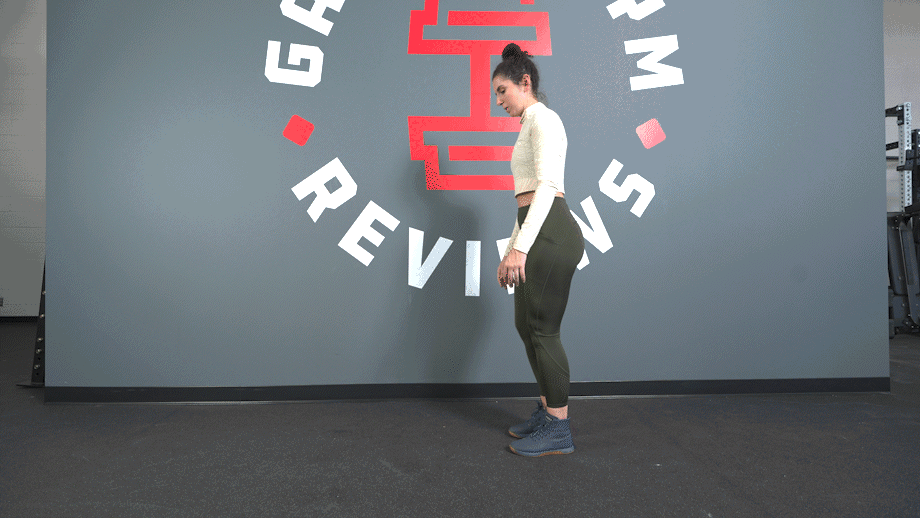
Calf Stretch
Muscles worked: Calves
Why do it: Although some of the other cool down exercises on this list activate the calves to some extent, calf stretches isolate them. You use your calves to walk, stand, run, squat, and more, so reducing stiffness and increasing flexibility in the calves can make a significant difference to your everyday life.
How to do it:
- Stand near a wall or a chair, placing your hands on it.
- Position your left leg behind your right leg (first, you’ll be stretching your left calf).
- Keeping both heels on the ground, bend your right knee and lean forward slightly.
- Hold for 20 to 30 seconds, then switch sides so your right leg is now behind you.
- Repeat the movement.
Benefits of Cool Down Exercises
Now you know how to do the best cool down exercises, you’re probably wondering, “What are the benefits of including them in my workout routine?” I’ve laid out the top three benefits below:
Reduces Lactic Acid
When you exercise, your body fuels your muscles with oxygen. However, according to the Cleveland Clinic7, there are times when your body can’t get oxygen to the muscles quickly enough, usually when the activity is intense. Instead, it breaks down glucose to create this energy, which is how lactic acid (aka lactate) is formed.
It can take some time for lactic acid to clear from your body. Cool down exercises may help reduce lactic acid, meaning your body can recover quicker.
Increases Flexibility
Regularly performing cool down exercises can help increase flexibility and improve your range of motion. This can decrease pain, reduce the risk of injuries, and, more importantly, help prepare you for your next training session. Maintaining and improving your flexibility is crucial as you age because your muscles naturally tighten and get shorter.
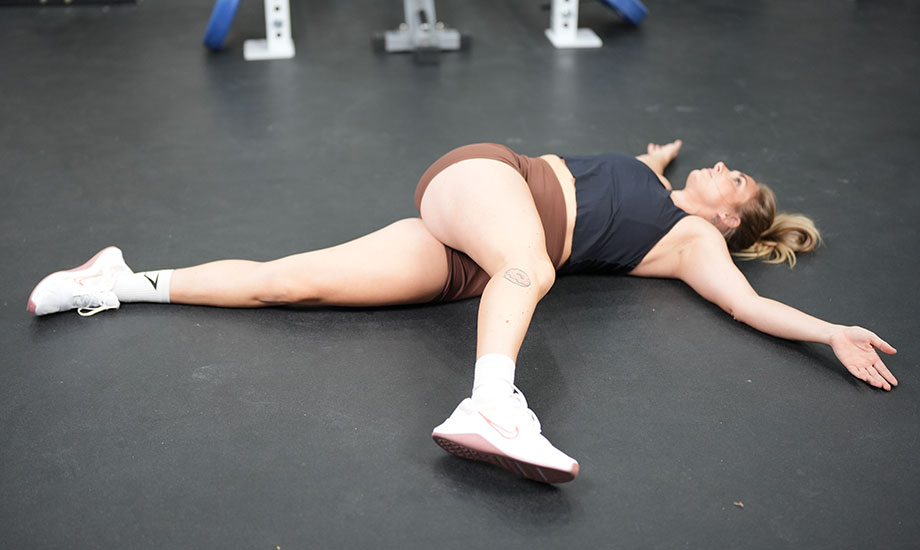
Returns Your Body To Pre-Exercise Levels
Doing any physical exercise—whether it’s cardio, weight training, or HIIT workouts—will increase your heart rate, blood pressure, and body temperature. You don’t want to go from this state to nothing in a matter of seconds. In the same way, you don’t want to go from nothing to doing intense activity in seconds. Cool down (and warm up!) exercises bridge this gap.
RELATED: HIIT Cardio Workouts At Home
How to Program Cool Down Exercises
Next, allow me to explain how to program these cool down exercises into different types of training:
Best Cool Down Routine for Upper-Body Workouts
Let’s say you’ve completed an upper-body workout at home. Include 30 to 60 seconds of the following exercises in your cool down:
- Chest stretch
- Cross-body shoulder stretch
- Triceps stretch
- Cat-cow stretch
- Neck circles
Best Cool Down Routine for Lower-Body Workouts
You’ve finished a lower-body workout with deadlifts, squats, and lunges. Add 30 to 60 seconds of a few (or all) of these exercises to complete your session:
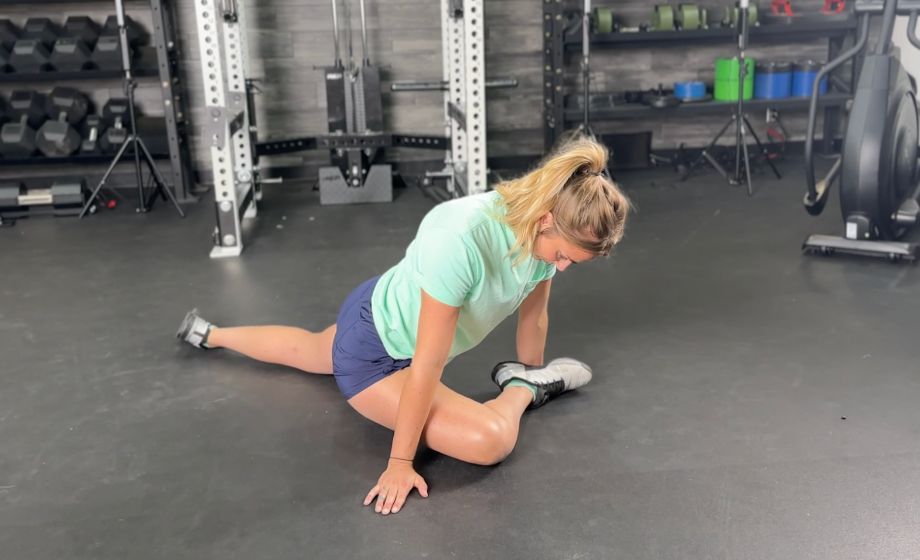
- Forward bend (or fold)
- Knee-to-chest pose
- Standing quad stretch
- Downward dog
- Pigeon pose
- World’s greatest stretch
- Iron cross stretch
Similarly, if you’re looking for the best cool down routine for runners after an intense run or sprint workout, you can add these cool down exercises.
Best Short Cool Down Routine
Here’s a cool down routine that targets your full body with only two exercises at 60 to 90 seconds each. If you’re short on time, give it a go:
- Downward dog
- World’s greatest stretch
Expert tip: It’s up to you which exercises you pick and how long you do them. If your time is limited, focus on the areas where you feel pain or discomfort. For example, for tight hamstrings after a run, spend more time on forward bends, downward dogs, and iron cross stretches.
Cool Down Exercises: Final Thoughts
I appreciate we’re all busy, and adding even a few extra minutes at the end of your workouts can feel like a burden. However, cool down exercises have multiple benefits, including reducing lactic acid, improving flexibility, and slowly returning your heart rate, blood pressure, and body temperature to pre-exercise levels.
- Add a light jog. After intense workouts, it’s worth adding a short (between two and five minutes) jog before you perform cool down exercises to give you extra time to recover.
- A few minutes is enough. A cool down routine doesn’t need to be a second workout. Perform a few exercises and get on with your day.
- Pick the right stretches. Following a run or intense sprints, you’ll benefit more from lower-body cool down exercises (rather than upper-body). Be smart about your choices.
Cool Down Exercises: FAQs
What are the 3 stages of a cool down?
The three stages of a cool down are:
– Initial phase
– Intermediate phase
– Late phase
Let’s say you’ve just finished a high-intensity workout. In phase one (the initial phase), instead of coming to a stop immediately, you’ll want to decrease your heart rate slowly. A light jog or brisk walk is recommended here.
In the intermediate phase, you want to do cool down exercises that are either dynamic or slightly more intense. Examples include the world’s greatest stretch and the iron cross stretch. This will further reduce your body temperature and help with flexibility.
For the final phase (late phase), you can do static stretches or less intense exercises such as child’s pose, the cat-cow stretch, or others. By the end, your body should have returned to pre-exercise levels.
What are good cool down exercises for running?
Good cool down exercises for running include, but are not limited to, the following:
– Forward bend (or fold)
– Knee-to-chest pose
– Standing quad stretch
– Downward dog
– Pigeon pose
– World’s greatest stretch
– Iron cross stretch
After a run, the muscles in the lower body (hamstrings, glutes, quadriceps, lower back, calves) are the most likely to be tight. The above exercises activate one or more of these muscles, which is why they’re great for runners.
RELATED: Post-Run Stretches
How do you make a cool down fun?
For me—a certified personal trainer—the best way to make your cool down fun is to experiment with different cool down exercises and not put pressure on yourself. It doesn’t need to last more than ten minutes or be rigid. If you want to do a certain exercise, do it. If you feel like using one of the best exercise bikes instead of jogging after a workout, go right ahead. At the end of your workout, doing something is better than nothing.
References
- Fradkin AJ, Zazryn TR, Smoliga JM. Effects of warming-up on physical performance: a systematic review with meta-analysis. J Strength Cond Res. 2010 Jan;24(1):140-8. doi: 10.1519/JSC.0b013e3181c643a0. PMID: 19996770.
- Dydyk AM, Sapra A. Williams Back Exercises. [Updated 2023 May 1]. In: StatPearls [Internet]. Treasure Island (FL): StatPearls Publishing; 2023 Jan-. Available from: https://www.ncbi.nlm.nih.gov/books/NBK551558/
- Attum B, Varacallo M. Anatomy, Bony Pelvis and Lower Limb: Thigh Muscles. [Updated 2022 Dec 17]. In: StatPearls [Internet]. Treasure Island (FL): StatPearls Publishing; 2023 Jan-. Available from: https://www.ncbi.nlm.nih.gov/books/NBK482445/
- Colgrove YM, Gravino-Dunn NS, Dinyer SC, Sis EA, Heier AC, Sharma NK. Physical and Physiological Effects of Yoga for an Underserved Population with Chronic Low Back Pain. Int J Yoga. 2019 Sep-Dec;12(3):252-264. doi: 10.4103/ijoy.IJOY_78_18. PMID: 31543635; PMCID: PMC6746048.
- Tiwana MS, Sinkler MA, Bordoni B. Anatomy, Shoulder and Upper Limb, Triceps Muscle. [Updated 2023 Aug 28]. In: StatPearls [Internet]. Treasure Island (FL): StatPearls Publishing; 2023 Jan-. Available from: https://www.ncbi.nlm.nih.gov/books/NBK536996/
- Cagnie B, Danneels L, Van Tiggelen D, De Loose V, Cambier D. Individual and work related risk factors for neck pain among office workers: a cross sectional study. Eur Spine J. 2007 May;16(5):679-86. doi: 10.1007/s00586-006-0269-7. Epub 2006 Dec 8. PMID: 17160393; PMCID: PMC2213555.
- Cleveland Clinic. What Is Lactic Acid?


